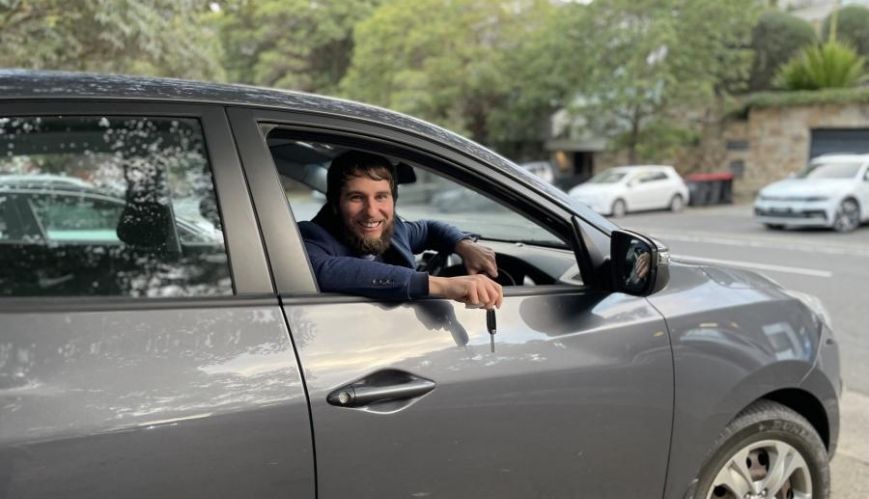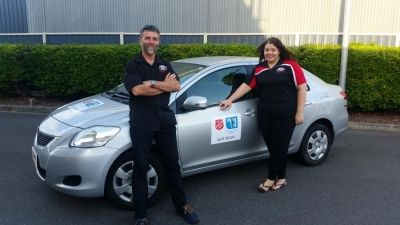Christopher takes Drive for Life wheel

Christopher takes Drive for Life wheel
30 August 2021
Christopher McKendrick has been handed the keys to steer Drive for Life, The Salvation Army’s national driver training program across the Australia Territory.
The Salvation Army’s national driver training program, Drive for Life, has a new man in the driver’s seat. When the rubber hits the road with anything to do with the program, Christopher McKendrick steers it.
Christopher started in his new role after recently concluding his job of five years as centre manager of the Army’s Oasis program in Surry Hills, Sydney, and as the principal of the special assistance school in that program.
Christopher said Drive for Life programs had been motoring along in Brisbane, Sydney and some regional areas of NSW and South Australia for several years, providing opportunities for mentoring young people. “It connects with people. It’s really practical,” he said.
He said the program was not only about “getting their Ps”, but it was a long-term commitment that had benefits that continued long after the young person earned their licence: “People can connect the dots with what [having a driver’s licence] means in terms of opportunities in employment.”
“Getting their Ps” was a side story for the young people going through the program: “The bigger story is in getting jobs, being able to travel places, education, employment. There are heaps of benefits beyond getting a licence,” Christopher said.
“We have noted a significant improvement in the wellbeing of young people when connected with our program. The program reduces feelings of isolation and connects young people with a community that cares for them and takes the time to support them to get a licence.”
Mentors had the opportunity to not only give direction and instruction but have “life-giving conversations” with the learner driver during the 70-100 hours spent in a car driving around the streets.
Christopher said the Drive for Life program provided an opportunity for members of Army faith communities to become excellent role models and mentors for at “risk young” people or those from other cultures and countries.
 Drive for Life Brisbane coordinator Wayne Norford (left) and Drive for Life Lawnton coordinator Cheryl Russo ... more Army mentors are needed to help young people get their driver’s licence.
Drive for Life Brisbane coordinator Wayne Norford (left) and Drive for Life Lawnton coordinator Cheryl Russo ... more Army mentors are needed to help young people get their driver’s licence.
Wayne Norford, who started the Drive for Live program in Brisbane four years ago, gave examples where mentors had helped young people choose and buy their first car, helped with repairs, draft job applications, helped with their studies, such was the trusted bond formed.
Wayne said that, often, the mentor got a larger blessing from being part of the program than the learner driver.
Christopher encouraged members of the Army to see being part of a driver training program as a ministry within their corps where “quite solid relationships” could be established: “We want people across The Salvation Army to know what we’re doing in this program, and we want to encourage volunteers. It’s an opportunity to participate in the program and to support young people in a practical way.”
Wayne said 183 young people had been through the Drive for Life Brisbane program since it began in August 2017, which equates to 6255 hours in the car. Brisbane’s neighbour, Drive for Life Lawnton, which began at a similar time, has had 111 young people go through, which coordinator Cheryl Rosso said was about 3600 hours of driving.
Wayne said the Drive for Life Brisbane began with a leased 2017 Toyota Corolla, and since then, a second-hand vehicle with dual pedals had been added.
He has about 30 mentors on his roster: “The qualities a mentor needs are patience, patience and patience,” Wayne said. He said it was almost a “default setting” for a young person getting behind the wheel for the first time to have in mind: ‘I can’t do this’.
“With a little bit of repetition, a little bit of encouragement and intelligent planning, there comes a moment where you can almost see the lights come, and they say: ‘I can do this’, and that is the gold in this program,” Wayne said. “It’s precious”.
He said that confidence came with gaining a skill such as driving and that confidence could be taken into other situations they face: “This job interview: ‘I can do this’. Moving into my own independent place: ‘I can do this’.
“That is the wonderful virtue of this program, but it can only happen when there's a mentor that facilitates that.”
Narissa, who went through the program in Brisbane, said Drive for Life had been “an incredible support to me and my driving”.
She said her mentor had helped in a “multitude of ways”, being patient and “giving 110 per cent to help me learn” and having adapted his training to suit her abilities: “His support and this program has seen me achieve goals faster than I ever could have on my own.”
In four years, Wayne said that apart from the usual scrapes and contact with poles and gutters that “go with the territory”, there had only been one crash and the dashboard camera footage cleared the learner of fault.
Christopher said funding, particularly from the government and corporate sector, was important to the long-term future of all the Drive for Life ministries around the country.
“We’re looking at building something that’s got real infrastructure in place and a solid model behind it, financially and operationally, and then we go where there’s a need and where we can source funding for it,” Christopher said.
“I’m excited about what comes next,” Christopher said.